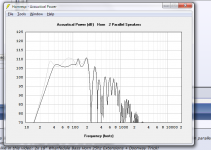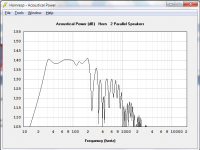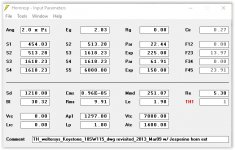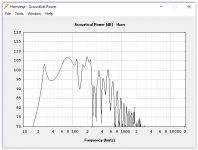Hi Djim,
Post #80: "...if simulators have the ability to 'unlock' the 'fixed' radiation angles?"
Maybe w/ AkAbak? But, I never got that to work correctly. Even my results w/ the Keystone exit didn't quite match the measurements. Have not had time to go back to that project...
Regards,
Post #80: "...if simulators have the ability to 'unlock' the 'fixed' radiation angles?"
Maybe w/ AkAbak? But, I never got that to work correctly. Even my results w/ the Keystone exit didn't quite match the measurements. Have not had time to go back to that project...
Regards,
Thanks guys. I think I just got excited applying some newly learned theory. Do you see any real advantage to shared horn extensions? Seems like a really novel way to approach things and offers alot of benefits.
Hi tb46 & Zwiller,
Oliver, the predicted impedance, peak and dips in output were all in place. In other words the behaviour of the 'K'-load was known. For me that's sufficiently precise to be applicable for other designs.
Sam, I once did a 'removable SS15 extender' for someone else. If it was 'undocked' it became a handy cable box ;-)
Cheers,
Djim
Oliver, the predicted impedance, peak and dips in output were all in place. In other words the behaviour of the 'K'-load was known. For me that's sufficiently precise to be applicable for other designs.
Sam, I once did a 'removable SS15 extender' for someone else. If it was 'undocked' it became a handy cable box ;-)
Cheers,
Djim
Sam,Thanks guys. I think I just got excited applying some newly learned theory. Do you see any real advantage to shared horn extensions? Seems like a really novel way to approach things and offers alot of benefits.
The advantages of horn extensions and wave-guides ("barn-doors") are several:
1) Some venues are simply too small to use a really large horn in.
2) Horn extensions can be made to nest like Dixie cups, as did the Community "Leviathan" horns from the 1970s, or can be made in four parts, like my 1977 (or 1978?) exponential FLH "Collapsable Crunchers", or the wave-guides described from this century. Any of those approaches can reduce the transport volume by as much as 90% compared to a single horn of equal size, but do require more set up time, construction is more difficult, and some extra hardware is required.
3) The two "tunings" (Fb or Fc) afforded allow a horn extension to be left off if program material does not require the extra LF (low frequency) extension. That said, a cabinet designed for horn extensions may be a compromise in either configuration, especially in TH compared to FLH designs.
4) Wave-guides can add 3-6 dB forward gain with no power compression, drastically reducing power demands for a given SPL compared to the same cabinets without, and require no special design consideration regardless of cabinet design- they work equally well on BR (bass-reflex), TH, or FLH. The bigger the wave-guide, the better, for more forward gain and reduced rear "wash", while also reducing SPL in the immediate near-field directly in front of the cabinets.
As far as shared horn extensions, they reduce the parts count compared to using a separate extension for each cabinet.
Art
Last edited:
Hello Art
I tested the keystones in a big place and it sounded absolutely amazing.
Level wise not close to near extreme level as in the small room where i tried last time.
(Is it me? or is it way louder when connected in parallel??)
But still very very nice, clean and powerfull.
And the 3/400 people that was there really enjoyed it.
We tested with a lot of different styles of electronic/bass music.
I want to build 2 more later
But for now i want to try and build some extension.
I think im gonna make first for 1, and later expand it so it can cover 2 together.
Do you (or anyone else) have a recomendation for a shape aiming for MAX low end extension?
Imagine size was not a problem.
I was thinking eventually something like in this video:
2x 18" Wharfedale Bass Horn 25hz Extensions + Doorway Trick!
https://www.youtube.com/watch?v=5o0s9jpYKBs
I tested the keystones in a big place and it sounded absolutely amazing.
Level wise not close to near extreme level as in the small room where i tried last time.
(Is it me? or is it way louder when connected in parallel??)
But still very very nice, clean and powerfull.
And the 3/400 people that was there really enjoyed it.
We tested with a lot of different styles of electronic/bass music.
I want to build 2 more later
But for now i want to try and build some extension.
I think im gonna make first for 1, and later expand it so it can cover 2 together.
Do you (or anyone else) have a recomendation for a shape aiming for MAX low end extension?
Imagine size was not a problem.
I was thinking eventually something like in this video:
2x 18" Wharfedale Bass Horn 25hz Extensions + Doorway Trick!
https://www.youtube.com/watch?v=5o0s9jpYKBs
Jesperino,1)Level wise not close to near extreme level as in the small room where i tried last time. (Is it me? or is it way louder when connected in parallel??)
2)Do you (or anyone else) have a recomendation for a shape aiming for MAX low end extension?
3)I was thinking eventually something like in this video: 2x 18" Wharfedale Bass Horn 25hz Extensions + Doorway Trick!
Thanks, glad you are enjoying your Keystones. I'm excited about my upcoming Keystone B-Low (or C-low) build, a taller version that will "dig a little deeper in the (LF) well".
1) A pair of any sub-woofers in parallel, assuming the amp can sustain the same voltage output with a pair vs one (most can not) located within 1/4 wavelength of the upper pass band will result in a 6 dB increase in SPL. In the low LF range of the Keystone, that SPL increase sounds about twice as loud.
2) I am not aware of any, other than the tips I recently suggested to Bjones prior to this year's Burning Man Fest in the Keystone thread.
3) See point # 3 in post #84 or in the OP here.
Cheers,
Art
Oliver/TB46 did a great job explaining how to sim an extension in HR and I wanted the info in this thread:
SNIP "here is what I did:
1. file name: TH1T_org - pick a TH simulation (this was a SS15/xoc1 style for the 18TBX100)
2. file name: TH1T_th1 - change from TH to TH1 (using EXP instead of PAR was closer in volume)
3. file name: TH1T_2x - double drivers/areas
4. file name: TH1T_2xE - add extender"
He even posted the HR files.
http://www.diyaudio.com/forums/subw...30-ft30-pa-th-awesomeness-89.html#post4819794
So based on these files here is 2 cabs with a shared horn extension vs 2 cabs. Shared horn in black and 2 cabs in grey. One thing is interesting is that FR changes a bit and I didn't expect it. A pair of the shared extension systems (4 cabs) looks pretty menacing if you ask me.
SNIP "here is what I did:
1. file name: TH1T_org - pick a TH simulation (this was a SS15/xoc1 style for the 18TBX100)
2. file name: TH1T_th1 - change from TH to TH1 (using EXP instead of PAR was closer in volume)
3. file name: TH1T_2x - double drivers/areas
4. file name: TH1T_2xE - add extender"
He even posted the HR files.
http://www.diyaudio.com/forums/subw...30-ft30-pa-th-awesomeness-89.html#post4819794
So based on these files here is 2 cabs with a shared horn extension vs 2 cabs. Shared horn in black and 2 cabs in grey. One thing is interesting is that FR changes a bit and I didn't expect it. A pair of the shared extension systems (4 cabs) looks pretty menacing if you ask me.
Attachments
Hi Art, I'm trying to wrap my head around whether a complete waveguide for one keystone cabinet will fit on a 4x8' sheet of plywood, based on your 15" depth, 45° cuts and info in post #40. To me it looks a little on the big side. Thanks!
Last edited:
Hi Osse,
I just did a "quick and dirty" in AutoCAD, so make sure you do your own drawing and dimensioning, but it looks like you're good to go. 🙂
Regards,
I just did a "quick and dirty" in AutoCAD, so make sure you do your own drawing and dimensioning, but it looks like you're good to go. 🙂
Regards,
I think I've re-measured every panel like 10 times tonight(got the same result evert time lol) to try make them fit the wrong way on the sheet so the panels should be fine, sometimes it's the simple solutions that's the hardest to see!
Thank you.
Thank you.
Osse,I think I've re-measured every panel like 10 times tonight(got the same result evert time lol) to try make them fit the wrong way on the sheet so the panels should be fine, sometimes it's the simple solutions that's the hardest to see!
Thank you.
Oliver's layout will roughly duplicate the wave-guide width and depth, as they are missing the alignment slots for the wings, made from 1" x .75" plywood strips, when recessed the wings are slightly smaller than the dimensions indicated.
I re- used the 90 degree (135 degree included angle) wave-guides for the last three sub designs (Welter Systems "C Horn, 2x12"BR, and Keystone, though I made mine with the bottom and top/center 56.25" on center, a second wave guide sharing the center, and extending up another 56.25" for low-mid & top cabinets.
There is no reason for you to "waste" any portion of a 4'x8', a wider, more shallow angle would increase frontal area and forward gain. In other words, you could make the barn door wings 38" wide, and top and bottom 9.825" deep.
Cheers,
Art
Last edited:
Hi Art, thanks for the explanation. To my eye back of top/bottom 26.5" +3"(1.5" on each side of top/bottom, for side panel/outer cleat to fit) seem the way to go. It looks like you have some cleat on the back of the top/bottom piece aswell to fix the panel against the cabinet?
The reason I wanna stick with 15" width/depth is its good for my choice of 106 hz x-over regarding 1/4th rule of distance of highest frequency when stacking cabs horizontally.
The reason I wanna stick with 15" width/depth is its good for my choice of 106 hz x-over regarding 1/4th rule of distance of highest frequency when stacking cabs horizontally.
Last edited:
I decided to try and make a kind of a waveguide/horn extension.
For now its more like a waveguide, but i would like to make it more like a horn extension.
Its 30" long
And the height start at 30" and expands up to 45" (same height as keystone)
Only tried it quickly in a small house.
The hole house was allready shaking a lot with just one Keystone on a little volume... So it was not easy to evaluate the extension because no matter what sounded way to crazy with high volume in that house.
The plan was to test it during the soundcheck, but we had to remove it so there was space for a band and the drumset.
(It is a pretty huge and heavy monster allready)
I was playing around with some sketchup and came up with this modification to make it more like a horn extension.
The hornpath is not expanding to much before the end of the mouth opening.
(And the front panel would be changed for another one for this setup with a different hole than the keyhole that have same size at the end of the keystone horn)
(Gonna try and upload some pics?)
(EDIT: seems like pics wont open unless i right click and say "Open Link In New Tab")
I have basically no idea if this will work as intended...
Any comments or sugestions are highly apreciated
Plan is to make 2 and use them like this:
I have some other horn folds in mind that im gonna try and play around with tomorrow...
For now its more like a waveguide, but i would like to make it more like a horn extension.
Its 30" long
And the height start at 30" and expands up to 45" (same height as keystone)
Only tried it quickly in a small house.
The hole house was allready shaking a lot with just one Keystone on a little volume... So it was not easy to evaluate the extension because no matter what sounded way to crazy with high volume in that house.
The plan was to test it during the soundcheck, but we had to remove it so there was space for a band and the drumset.
(It is a pretty huge and heavy monster allready)
I was playing around with some sketchup and came up with this modification to make it more like a horn extension.
The hornpath is not expanding to much before the end of the mouth opening.
(And the front panel would be changed for another one for this setup with a different hole than the keyhole that have same size at the end of the keystone horn)
(Gonna try and upload some pics?)
(EDIT: seems like pics wont open unless i right click and say "Open Link In New Tab")
An externally hosted image should be here but it was not working when we last tested it.
An externally hosted image should be here but it was not working when we last tested it.
An externally hosted image should be here but it was not working when we last tested it.
I have basically no idea if this will work as intended...
Any comments or sugestions are highly apreciated
Plan is to make 2 and use them like this:
An externally hosted image should be here but it was not working when we last tested it.
I have some other horn folds in mind that im gonna try and play around with tomorrow...
Last edited:
Ahh had another more simple horn fold.
Horn expands more than the other one,
But waste quite some space...
Horn expands more than the other one,
But waste quite some space...
An externally hosted image should be here but it was not working when we last tested it.
An externally hosted image should be here but it was not working when we last tested it.
An externally hosted image should be here but it was not working when we last tested it.
Posts #95/96
Hi Jesperino,
You are designing a whole new enclosure. You could try to simulate this in Hornresp using the TH1 Driver Arrangement. I'll attach a quick stab at this, I made no attempt to arrive at a design or accurate numbers, just move the sliders around in the Wizard, and see what happens.
Regards,
Hi Jesperino,
You are designing a whole new enclosure. You could try to simulate this in Hornresp using the TH1 Driver Arrangement. I'll attach a quick stab at this, I made no attempt to arrive at a design or accurate numbers, just move the sliders around in the Wizard, and see what happens.
Regards,
Attachments
1) Yes, the side "wings" have a 90 degree bracket cut from "2x4" lumber.1) It looks like you have some cleat on the back of the top/bottom piece aswell to fix the panel against the cabinet?
2)The reason I wanna stick with 15" width/depth is its good for my choice of 106 hz x-over regarding 1/4th rule of distance of highest frequency when stacking cabs horizontally.
2) If you want the two cabinets to be within 1/4 wavelength at 106 Hz, they need to be side by side, with wings on either side. The wings are simply "barn doors", the depth can be as shallow as you like, as long as it still stands by itself in a moderate breeze before attachment with whatever method you choose.
Yes i guess there is no way out...
Need to learn HornResp :O
Last time when i tried to sim the RCF LF18X451 in the keystone it didnt turn out well...
So i cant imagine how it will go trying to simulate this monster horn...
I think i could learn russian and chinese before i learn horn resp hehehe
But OK
Here we go!!!
Need to learn HornResp :O
Last time when i tried to sim the RCF LF18X451 in the keystone it didnt turn out well...
So i cant imagine how it will go trying to simulate this monster horn...
I think i could learn russian and chinese before i learn horn resp hehehe
But OK
Here we go!!!
Hi Jesperino,
Let's see, I just answered a question regarding the use of Hornresp, so here are some links/hints:
http://www.hometheatershack.com/for...scussion/36532-hornresp-dum-hmm-everyone.html
DIY Speakers and Subs - AVS Forum | Home Theater Discussions And Reviews
These are the two that immediately come to mind. David McBean has improved the Help file a lot, and the above tutorials are a little behind.
First try to get a hang of entering driver data, and then get the ideas of what goes where (chambers/ducts), do a few simple examples: sealed/vented/1/4 wave pipe then go on to the tapped horns.
For entering driver data: enter Sd first / double-click on Cms and enter Vas / double-click on Mmd and enter Fs / enter Re and Le / double-click on Rms and enter Qms / double-click on Bl and enter Qes /// to check: double-click on Sd, and a window will show what was entered, and what Hornresp calculated, also, here we can enter Pmax and Xmax.
Look at a few known good Hornresp simulations, and there you go... 🙂.
Regards,
Let's see, I just answered a question regarding the use of Hornresp, so here are some links/hints:
http://www.hometheatershack.com/for...scussion/36532-hornresp-dum-hmm-everyone.html
DIY Speakers and Subs - AVS Forum | Home Theater Discussions And Reviews
These are the two that immediately come to mind. David McBean has improved the Help file a lot, and the above tutorials are a little behind.
First try to get a hang of entering driver data, and then get the ideas of what goes where (chambers/ducts), do a few simple examples: sealed/vented/1/4 wave pipe then go on to the tapped horns.
For entering driver data: enter Sd first / double-click on Cms and enter Vas / double-click on Mmd and enter Fs / enter Re and Le / double-click on Rms and enter Qms / double-click on Bl and enter Qes /// to check: double-click on Sd, and a window will show what was entered, and what Hornresp calculated, also, here we can enter Pmax and Xmax.
Look at a few known good Hornresp simulations, and there you go... 🙂.
Regards,
- Home
- Loudspeakers
- Subwoofers
- Horn Extender/Wave-guide for TH



